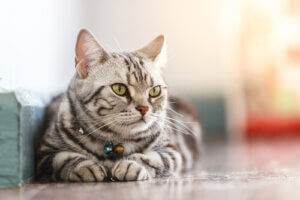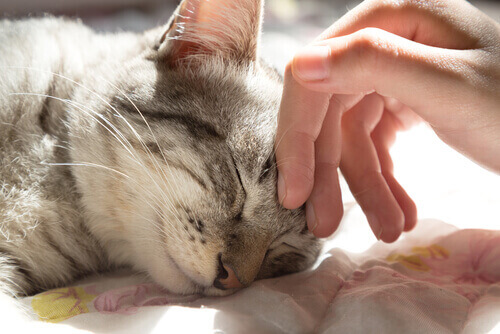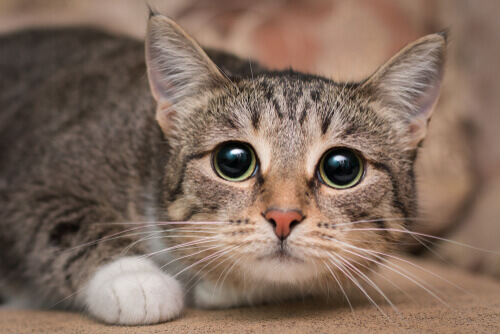The Science Behind the Well-Being of Domestic Cats


Written and verified by the biologist Samuel Sanchez
The well-being of domestic cats is often taken for granted unless they have symptoms of serious illness. This is because minor emotional imbalances are often hard to identify. It’s also because owners lead busy lives.
The stimuli they’re constantly exposed to, as well as all their daily concerns, make it even harder to worry too much about an animal. Do you ever wonder what things can make a cat happy or unhappy? Continue reading to find out.
The well-being of domestic cats is due to a symbiosis lasting thousands of years
We’re not absolutely certain about the beginning of the interaction between cats and humans. The common belief is that this symbiotic relationship began in Ancient Egypt. However, recent fossil evidence indicates it may have begun way earlier — about 7000 years ago. People have loved and feared cats ever since.
Currently, cats are mainly pets. Estimates indicate that millions of them currently reside in households all over the world. Due to their social and individual importance, these animals have are one more member of the family. As such, they receive attention, understanding, and empathy from their guardians.
Today we’re going to tell you about various factors that can determine the well-being of a domestic cat to a certain extent. We’ll do so based on a study published on ScienceDirect.

An interesting study
The study mentioned above set the objective of exploring different factors when quantifying a feline’s well-being. The methodology was as follows:
- Researchers gathered a sample group of 62 owners and their cats; these people didn’t know the objective of the study
- They quantified the relationship between the cat and the owner using various parameters such as questionnaires, a physical examination of the animal, and the Lexington Attachment to Pets Scale (LAPS)
- Then, they calculated a total score for each interaction, according to the well-being of the cat: low (L), medium (M), or high (H)
- These parameters allowed the researchers to get a clear idea of the social, behavioral, and physiological status of each animal
The average profile of a participant was slightly biased, as most were female employees with previous experience in caring for cats. The results are still rather interesting though.
The well-being of domestic cats depends upon these factors
The study elucidated several points.
- The outcome was good because, when it comes to a cat’s quality of life, more than 70% of them obtained an average score and 17% a high one
- The cats’ general physical condition was excellent, as 75% of them obtained a high score
- Factors such as gender, age, number of members in the family, and an owner’s social activities seemed to condition these percentages
The data is both curious and positive, but note that only 16% of domestic cats didn’t show any abnormal behavior for their species. This means that, although the owners paid a lot of attention to the animal, they couldn’t fully meet their needs. OK, so what promotes the well-being of a domestic cat, then?
Cats looked after by several people seem to receive more veterinary care. This underlines the importance of all members of a family feeling responsible for the animal and providing them with the best possible care.
The cats belonging to people who had previously owned a cat had fewer behavioral problems — such as tearing objects apart. This could be because more experienced owners know the kind of stimuli that an animal requires. It never hurts to mention that scratching posts and toys are essential for a cat’s mental condition.
Furthermore, defecation outside the litter box can be a sign of a stressed animal. The results are surprising, as these behaviors were drastically lower in cats from a childless family.
Again, this highlights the need to properly teach our children to have the utmost respect for all living beings. Especially for the pets in their household.

An owner’s responsibility
These results don’t mean that an animal will suffer more if there are children at home or if their owners have no previous experience with pets, or even if they only have one owner.
What this type of study shows is the need to understand the greatest weaknesses and deficiencies in an animal’s environment. So, if you’re a cat owner, pay special attention to them and try to fix any problems.
For example, if you have children at home, focus your time and energy on teaching them to respect the animal. They shouldn’t handle it roughly or be too noisy around them.
All cited sources were thoroughly reviewed by our team to ensure their quality, reliability, currency, and validity. The bibliography of this article was considered reliable and of academic or scientific accuracy.
-
Owner and cat features influence the quality of life of the cat, ScienceDirect. Recogido a día 10 de mayo en https://www.sciencedirect.com/science/article/abs/pii/S0168159105000511
This text is provided for informational purposes only and does not replace consultation with a professional. If in doubt, consult your specialist.